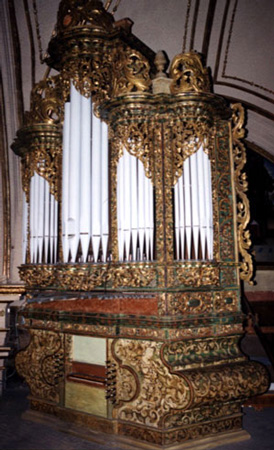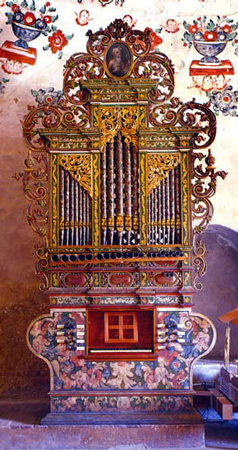Oaxaca City, Mexico
January 2009
We
visited Oaxaca in 1998 with Pat's parents, John and June.
After
John's death June wanted to return to Oaxaca but she decided to go
to
Merida
first so we never made it back to Oaxaca. This trip is an
homage
to June.

Pat, John and June in 1998
We spent 10 wonderful days in Oaxaca city staying at Casa Maye. More on Casa Maye on page 3.
There is so much to see and say about Oaxaca - it is a colonial city with an ancient past and a modern city with industry and culture. We skipped many of the museums we had visited before, but who can resist the baroque churches? Let's get them out of the way first:
The Churches

The cathedral is next to the zocalo, so you are unlikely to miss it. The stone gives the city its nickname "The Emerald City". I had to be told it was green.

Santa Domingo de Guzman is considered the "must see" church. Some of the stone here is greener.



Guadalupe church was at the north end of Llano Park and near our apartment

Soledad church is home of one of the 26 baroque organs in Oaxaca build before 1776. Most have been restored and are being used today. Unfortunately there were no concerts while we were there. There is an International Organ Festival in February. See http://www.iohio.org/eng/home.htm


The side entrance of Soledad and the organ.

Zaachila is a small ruin site near Oaxaca. We took a second class bus to see the ruin and the market.

Pat atop the tombs with an unexcavated site behind her.

There are several great carvings inside the tombs.

More carvings.

Lambityeco is a site currently undergoing excavation and restoration, with shelter and viewing platforms for tourists.

Sun god carvings in the tomb.

These carvings are reproductions, the originals are in a museum.

Some attractive stonework.

The ruins at Mitla are famous for these greca, or Greek style fretwork. We bought a rug with these designs on our first visit..

There are 9 basic designs repeated dozens of times.

A tourist with her guide.

Some of the original decoration has survived.

... and dozens.


Pablo converses with an archaeologist carefully measuring and recording every detail. The fretwork was carefully engineered not only to be beautiful but to be strong, shed rain, etc.

The church at Mitla was built over some of the ruins, and even used Mixtec stones in its construction.



Pat, John and June in 1998
We spent 10 wonderful days in Oaxaca city staying at Casa Maye. More on Casa Maye on page 3.
There is so much to see and say about Oaxaca - it is a colonial city with an ancient past and a modern city with industry and culture. We skipped many of the museums we had visited before, but who can resist the baroque churches? Let's get them out of the way first:
The Churches

The cathedral is next to the zocalo, so you are unlikely to miss it. The stone gives the city its nickname "The Emerald City". I had to be told it was green.

Santa Domingo de Guzman is considered the "must see" church. Some of the stone here is greener.

Santa Domingo interior.

Work was going on when we
visited. The man was carving; the women painting, first
white
gesso, then pink gesso, then gilt.

Guadalupe church was at the north end of Llano Park and near our apartment

Soledad church is home of one of the 26 baroque organs in Oaxaca build before 1776. Most have been restored and are being used today. Unfortunately there were no concerts while we were there. There is an International Organ Festival in February. See http://www.iohio.org/eng/home.htm


The side entrance of Soledad and the organ.
The Ruins
Another attraction of Oaxaca is the Mixtec and Zapotec ruins.
Zaachila is a small ruin site near Oaxaca. We took a second class bus to see the ruin and the market.

Pat atop the tombs with an unexcavated site behind her.

There are several great carvings inside the tombs.

More carvings.

Lambityeco is a site currently undergoing excavation and restoration, with shelter and viewing platforms for tourists.

Sun god carvings in the tomb.

These carvings are reproductions, the originals are in a museum.

Some attractive stonework.

The ruins at Mitla are famous for these greca, or Greek style fretwork. We bought a rug with these designs on our first visit..

There are 9 basic designs repeated dozens of times.

A tourist with her guide.

Some of the original decoration has survived.

... and dozens.


Pablo converses with an archaeologist carefully measuring and recording every detail. The fretwork was carefully engineered not only to be beautiful but to be strong, shed rain, etc.

The church at Mitla was built over some of the ruins, and even used Mixtec stones in its construction.

San Jeronimo church in
Tlacochahuaya was restored for a visit of the Queen of
Spain.
Another restoration is going on now, so we could not go inside
and see
the interior and the baroque organ.

Another view of San
Jeronimo. It
is 11 miles outside Oaxaca on the way to Mitla.


San Jeronimo organ and detail of the pipes.

Monte Alban is the king of the ruin sites. It is built on a hilltop overlooking the Oaxaca valley only a few miles from Oaxaca City and a shuttle service takes you there and back for $5. These pictures give some idea of the size but cannot convey the grandeur. A must see.

Continued on oaxaca2.htm
OTHER LINKS:
Our trip to Merida see http://stevebottorff.com/Merida/
For more about the baroque organs in Oaxaca see
http://www.iohio.org.mx/eng/home.htm
For more about San Jeronimo church see
http://si-oaxaca.com/Tlacochahuaya.htm
For a Oaxaca guidebook we recommend Viva Oaxaca
http://si-oaxaca.com/
Back to our Home page
http://stevebottorff.com

San Jeronimo organ and detail of the pipes.

Monte Alban is the king of the ruin sites. It is built on a hilltop overlooking the Oaxaca valley only a few miles from Oaxaca City and a shuttle service takes you there and back for $5. These pictures give some idea of the size but cannot convey the grandeur. A must see.

Continued on oaxaca2.htm
OTHER LINKS:
Our trip to Merida see http://stevebottorff.com/Merida/
For more about the baroque organs in Oaxaca see
http://www.iohio.org.mx/eng/home.htm
For more about San Jeronimo church see
http://si-oaxaca.com/Tlacochahuaya.htm
For a Oaxaca guidebook we recommend Viva Oaxaca
http://si-oaxaca.com/
Back to our Home page
http://stevebottorff.com